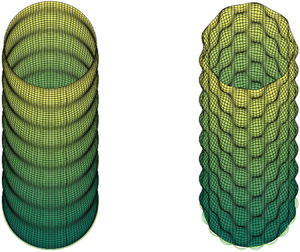Article contents
Poiseuille flow in rough pipes: linear instability induced by vortex–wave interactions
Published online by Cambridge University Press: 03 March 2021
Abstract

The instability of Hagen–Poiseuille flow in a rough pipe is considered and it is shown that for arbitrarily small roughness amplitudes the flow is unstable for sufficiently large values of the Reynolds number. Various models of wall roughness are considered and, if  $\epsilon$ is a typical amplitude of the roughness, it is shown that the flow is unstable when the Reynolds number
$\epsilon$ is a typical amplitude of the roughness, it is shown that the flow is unstable when the Reynolds number  $R> C {\epsilon ^{-({3}/{2})} \vert {\log \epsilon }\vert ^{-({3}/{4})}}$ where
$R> C {\epsilon ^{-({3}/{2})} \vert {\log \epsilon }\vert ^{-({3}/{4})}}$ where  $C$ is a constant which depends on the roughness shape and is typically in the range 10–40. The roughness is assumed to vary on the same length scale as the pipe radius. In the limit of short scale roughness varying most quickly in the streamwise direction, a quite general condition for instability,
$C$ is a constant which depends on the roughness shape and is typically in the range 10–40. The roughness is assumed to vary on the same length scale as the pipe radius. In the limit of short scale roughness varying most quickly in the streamwise direction, a quite general condition for instability,  $R_b > {3.16 [{b}/{h}]^{3/4}} /{(\log [{b}/{h}])^{3/8}}$, is found in terms of just the Reynolds number
$R_b > {3.16 [{b}/{h}]^{3/4}} /{(\log [{b}/{h}])^{3/8}}$, is found in terms of just the Reynolds number  $R_b$ based on the friction velocity, the streamwise length scale
$R_b$ based on the friction velocity, the streamwise length scale  $b$ and
$b$ and  $h$, the height of the roughness. The instability mechanism described is closely linked to vortex–wave interaction theory and applies to both two- and three-dimensional roughness shapes and takes the form of a roll-streak-wave flow. The interaction sustaining the instability occurs in a viscous boundary layer at the pipe wall but the roll-streak flow persists throughout the pipe. The most dangerous roughness shapes are found and generic results are also given for when the roughness length scale is small compared to the pipe radius.
$h$, the height of the roughness. The instability mechanism described is closely linked to vortex–wave interaction theory and applies to both two- and three-dimensional roughness shapes and takes the form of a roll-streak-wave flow. The interaction sustaining the instability occurs in a viscous boundary layer at the pipe wall but the roll-streak flow persists throughout the pipe. The most dangerous roughness shapes are found and generic results are also given for when the roughness length scale is small compared to the pipe radius.
- Type
- JFM Papers
- Information
- Copyright
- © The Author(s), 2021. Published by Cambridge University Press
References
REFERENCES
- 6
- Cited by



